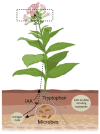Unraveling the Complexities of Flowering in Ornamental Plants: The Interplay of Genetics, Hormonal Networks, and Microbiome
- PMID: 40219203
- PMCID: PMC11991662
- DOI: 10.3390/plants14071131
Unraveling the Complexities of Flowering in Ornamental Plants: The Interplay of Genetics, Hormonal Networks, and Microbiome
Abstract
In ornamental plants, one of the most complex life processes, i.e., flowering, is regulated by interaction between the microbiota, hormones, and genes. Flowering plays an integral role in overall development and is quintessential for reproduction. Considering its importance, this review explores the complex mechanisms that determine the induction of flowering, highlighting the relationship between hormonal and genetic networks as well as the growing significance of the microbiome. Important genes involved in genetic control include FT, SOC1, and LFY. These genes react to environmental stimuli like photoperiod and vernalization. Auxins, cytokinin, and gibberellins are only a few hormone pathways important for floral growth and timing. The importance of plant-microbe interactions has been emphasized by current research, which shows that the microbiome affects flowering through processes like hormone production and availability of food. A comprehensive understanding of flowering induction is possible by integrating results from microbiota, hormones, and genetics studies, which may improve the breeding and culture of ornamental plants. For researchers to understand the complexity of flowering in ornamental plants and develop unique breeding strategies and improved floral qualities, it is critical to use interdisciplinary approaches, as this comprehensive investigation demonstrates.
Keywords: FT; LFY genes; SOC1; flower induction; plant hormones; plant microbiome interaction.
Conflict of interest statement
The authors declare that they have no conflicts of interest.
Figures




References
-
- Volckaert E., Gobin B., Verheye W. Ornamental plants and floriculture. In: Verheye W.H., editor. Soils, Plant Growth and Crop Production. Volume 3 EOLSS Publications; Paris, France: 2010.
-
- Yahia E.M. Postharvest Technology of Perishable Horticultural Commodities. Elsevier; Amsterdam, The Netherlands: 2019. Classification of horticultural commodities; pp. 71–97.
-
- Gabellini S., Scaramuzzi S. Evolving consumption trends, marketing strategies, and governance settings in ornamental horticulture: A grey literature review. Horticulturae. 2022;8:234. doi: 10.3390/horticulturae8030234. - DOI
-
- Hendricks J., Briercliffe T., Oosterom B., Treer A., Kok G., Edwards T., Kong H. International Vision Project Reports. AIPH Horticulture House; Chilton Didcot, Oxfordshire, UK: 2019. Ornamental Horticulture, A Growing Industry.
-
- Löbke A. Record Sales for the Flower and Plant Market. Messe Essen GmbH; Essen, Germany: 2022.
Publication types
LinkOut - more resources
Full Text Sources

